Understanding Legionnaires' Disease
Introduction
A recent Legionnaires' disease cluster in the Harlem area of New York City has caused three deaths and sickened over 60 people. This outbreak has raised concerns and questions about the nature of the disease and how it is contracted. So, what exactly is Legionnaires' disease and how does one get it?
What is Legionnaires' Disease?
Legionnaires' disease is a severe form of pneumonia caused by the bacteria Legionella. These bacteria are commonly found in water sources such as hot tubs, cooling towers, and large plumbing systems. The disease is not contagious and can only be contracted by breathing in mist or vapor containing the bacteria.
Symptoms and Risk Factors
The symptoms of Legionnaires' disease are similar to other forms of pneumonia, including cough, fever, and difficulty breathing. However, it can also cause headaches, muscle aches, and confusion. Those at higher risk for the disease include individuals over 50 years old, smokers, and people with weakened immune systems.
Prevention and Treatment
Preventing Legionnaires' disease involves proper maintenance and disinfection of water systems. Treatment typically involves antibiotics, and most people fully recover with timely medical care. However, the disease can be fatal, especially for those with underlying health conditions.
Conclusion
About the Organizations Mentioned
Legionella
The term "Legionella" primarily refers to a genus of bacteria responsible for legionellosis, which includes Legionnaires' disease and Pontiac fever—conditions ranging from mild flu-like symptoms to severe, sometimes fatal pneumonia. Legionella bacteria are naturally found in freshwater environments such as lakes and rivers but become a significant health concern when they proliferate in human-made water systems like plumbing, cooling towers, hot tubs, and fountains[1][2][4]. Legionella was first identified in 1976 following a pneumonia outbreak at an American Legion convention in Philadelphia, which led to the discovery of *Legionella pneumophila* as its cause[2][1]. Since then, Legionella has been recognized as a critical environmental health challenge, with reported cases of legionellosis increasing dramatically—by over fivefold since 2000—prompting greater focus on public health, water system management, and prevention strategies[2][3]. The bacteria thrive in warm water environments (25–45°C) and often colonize biofilms within complex plumbing systems, especially in large buildings such as hospitals, hotels, and office complexes. These settings provide ideal growth conditions, including stagnant water and sediment accumulation[5]. Legionella outbreaks are commonly linked to poorly maintained water systems where aerosolized water droplets harboring the bacteria are inhaled, leading to infection[1][3]. Key achievements in combating Legionella include the development of water management programs aimed at identifying and controlling bacterial growth in building water systems. Regulatory bodies such as OSHA and the CDC emphasize these programs to reduce worker and public exposure by monitoring water system components, applying control measures, and responding promptly to contamination risks[3][7]. Currently, Legionella remains a significant public health concern globally, with ongoing investigations into outbreak clusters (e.g., recent cases in New York City) and continued research into detection, prevention, and treatment protocols. The bacteria’s resilience in built environments and the complexity of controlling it
🔗 Connected Events Overview
Discover related stories and their connections to this article
📊 Quick Insights
📅 Connected Events Timeline
Explore connected events with detailed insights and relationships
👥 People Involved in Connected Events
🏢 Organizations & Products
Key entities mentioned across connected events
🏢 Organizations
🛍️ Products
💡 Connected Events Insights
Discover patterns and trends across related stories


